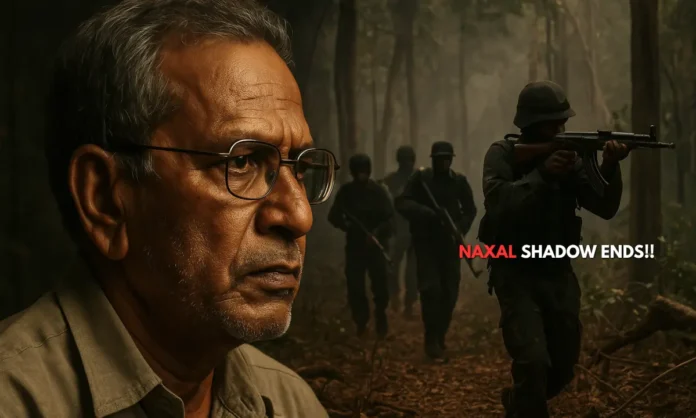Summary
- Nambala Keshav Rao, the CPI-Maoist General Secretary and mastermind of deadly insurgent attacks, was killed in a Bastar encounter with Indian forces.
- His death marks the most significant blow to the Maoist insurgency in over three decades, celebrated by top Indian security and political leaders.
- Rao’s life traced India’s deepest ideological fault lines—from radical student politics to militarised extremism rooted in the forests of Dandakaranya.
The Fall of a Phantom: How the Most Wanted Maoist Was Finally Hunted
For nearly half a century, Nambala Keshav Rao operated from the shadows. Known by names like Basavaraju and Gaganna, he was the invisible hand behind some of India’s deadliest Naxal attacks. But this week, his long flight from state forces ended in the forests of Bastar. In an encounter near Maad—deep within Chhattisgarh’s insurgent heartland—Rao was killed alongside 26 other Maoists by a joint team of COBRA commandos and state police.
Home Minister Amit Shah wasted no time in calling the operation a “landmark achievement.” Prime Minister Narendra Modi praised the security forces for their precision. The significance of Rao’s death is hard to overstate: as CPI-Maoist General Secretary and head of its Central Military Commission, he was the ideological and operational spine of India’s Naxalite insurgency.
This is the first time since the 1990s that a Maoist leader of Rao’s stature has been neutralized. More than just a tactical win, the strike signals a possible turning point in a decades-long low-intensity civil conflict that has bled India’s central and eastern regions.
Central Committee member and Politburo member Nambala Kesava Rao killed in encounter, Long live comrade in the hearts of Adivasis, Daliths, and other backward castes..#LongLiveRevolution pic.twitter.com/XmysK7X88E
— Muppala Rao (@MuppalaRao1) May 21, 2025
A Legacy of Fire: From Engineering College to Guerrilla Command
- Rao’s radicalisation began in the 1970s through the Radical Students Union at Warangal’s REC (now NIT).
- He co-founded CPI(ML) People’s War and was instrumental in the 2004 merger that formed CPI(Maoist).
- His military strategies, including the 2010 Dantewada ambush, made him India’s most feared Naxal tactician.
- Rao was trained in guerrilla warfare by ex-LTTE fighters and mastered IED deployment in the Dandakaranya region.
Born in 1955 in Srikakulam district of Andhra Pradesh, Nambala Keshav Rao was not always destined to be a revolutionary. He began his adult life as an engineering student, but the turbulence of the 1970s drew him toward the Naxalite cause. His involvement with the Radical Students Union was the gateway to a path that would eventually make him India’s most wanted insurgent.
Arrested in 1980 after a violent clash with ABVP cadres, Rao vanished into the underground shortly after. He played a crucial role in consolidating Maoist strength in Andhra Pradesh’s tribal belts and became a Central Committee member by 1992. But it was his leadership in the 2004 merger of CPI(ML) People’s War with Maoist Communist Centre that placed him at the strategic helm of a pan-India insurgency.
His military mind was sharpened by tactical training from former LTTE operatives. Rao engineered deadly operations including the Dantewada ambush in 2010 that killed 76 CRPF jawans, and the Jeeram Ghati massacre in 2013 that wiped out senior Congress leaders. His ability to evade security networks and sustain guerrilla cells for decades earned him a ₹1.5 crore bounty—and the aura of a ghost general.
Strategic Earthquake: Why Rao’s Death Matters Now
- This is the first time in 30 years that a Maoist leader of Rao’s rank has been eliminated by Indian forces.
- The neutralisation of Company-7, a core combat unit, further depletes Maoist operational capabilities.
- Key aides like Madhu and Naveen, also killed in the operation, signal a broader organisational collapse.
- The killing comes amid a shifting security doctrine emphasizing hybrid warfare and local intelligence networks.
The Bastar operation wasn’t just about Rao—it also dismantled key segments of the Maoist military wing. Alongside him, leaders like Madhu of the Dandakaranya Special Zonal Committee and Jung editor Naveen were killed, wiping out ideological as well as tactical command structures. The strike effectively decimated the Maoists’ Company-7 unit, a hardened faction operating in one of their last strongholds.
Security officials say this marks a turning point in the counterinsurgency doctrine. Intelligence-led hybrid operations involving COBRA and DRG units, combined with increased local surveillance and aerial mapping, are giving the state the upper hand. But the real coup lies in eliminating Rao himself—a man who managed to lead a mobile command structure across state borders for decades.
Union Home Ministry insiders hint at renewed pushes into the remaining Maoist corridors of Bijapur, Sukma, and Gadchiroli. For a movement already strained by waning recruitment and ideological drift, Rao’s death may accelerate internal fractures.
Echoes from the Forest: What Comes After the Red General?
Nambala Keshav Rao’s death is not the end of Naxalism. But it is the end of an era. His arc—from student radical to top insurgent—is a reflection of the deeper fault lines in Indian society: tribal marginalisation, land alienation, and the failure of development in conflict zones.
The CPI(Maoist) may name a new general secretary, but it is unlikely to find someone with Rao’s combination of ideological discipline, guerrilla genius, and organisational loyalty. His absence leaves a vacuum that splinter factions will struggle to fill. Moreover, the state’s newer strategies of engagement—combining welfare with warfare—are finally beginning to show results in long-neglected districts.
Yet, observers caution against premature declarations of victory. Rao’s life proves that insurgency is not always fuelled by arms—it is often born of despair. If the structural roots of discontent are not addressed—displacement, corruption, abuse—new leaders will emerge, perhaps with a different flag but the same fire.
Rao may be gone, but his ghost still haunts the forests of Bastar.


